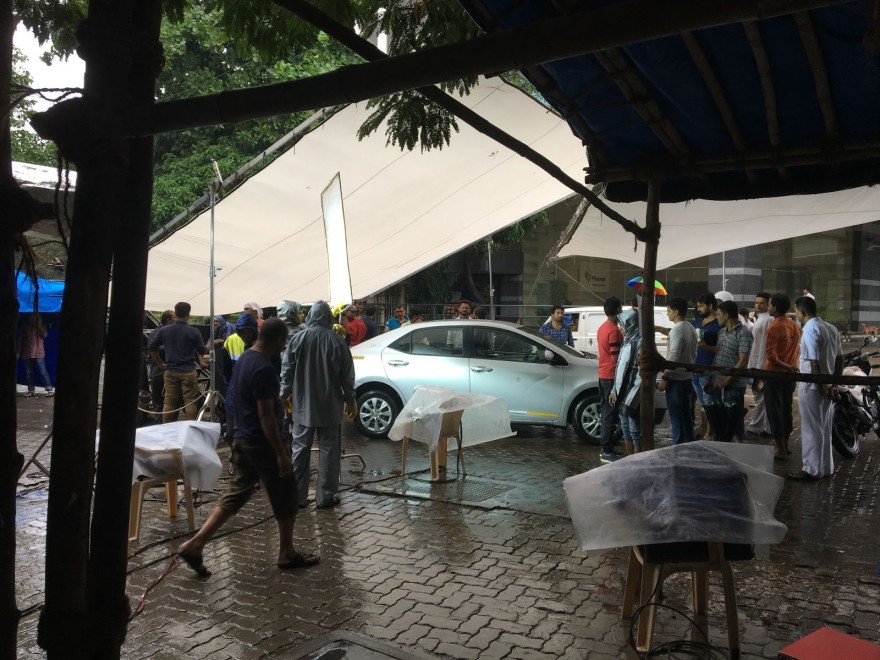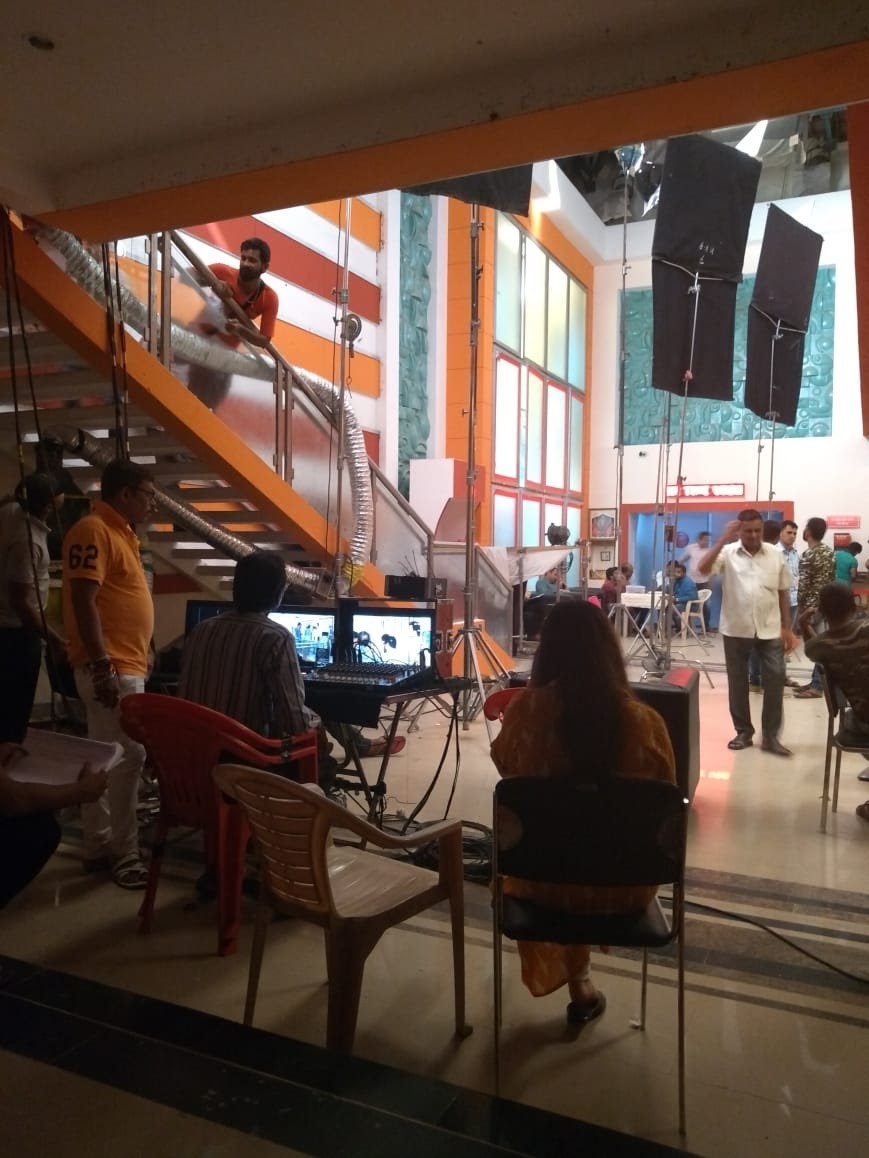On a regular day, a Hindi soap opera production set in Mumbai is home to upwards of 100 artists and technicians – production associates, actors, make-up artists, costume artists, lighting technicians, assistant directors, creatives, and spot boys. Their collective efforts ensure that audiences have new episodes to look forward to daily. Come rain, hail, or shine, through collaborations and conflicts, together they build melodramatic worlds that entertain millions of households in India.

Killick Nixon Studio, Mumbai, India. (Photo by author)
But what happens when the meaning of “regular” is redefined? What happens when even two become a crowd? When the first wave of COVID-19 hit Mumbai in March 2020, it brought, among other things, the Hindi soap opera industry to a halt. Daily production activities of soap operas across channels were abruptly paused. Sets had to be abandoned in haste when a citywide lockdown was announced. The absence of film work meant that workers would go without payments and a livelihood. Desolate filming sets also meant that new content would truly remain an exercise in imagination with no physical or material means to fulfill it. In the midst of all of this I, a soap opera viewer, resigned myself to the reality of not having new episodes to watch. And, as an anthropology doctoral student who claims to study daily Hindi soap opera production in Mumbai for her dissertation, I sat halfway across the world in the US with no prospects of travel. Especially daunting was the likelihood of not being able to do fieldwork in the near future.
In this mostly-personal-and-a-little-professional piece, I attempt to reflect over some of the questions that have niggled at me since the pandemic splintered our ability to… be. As a media anthropologist I am forced to ask: what happens to serials or “daily soaps” when they are no longer “serial” or “daily”? How do their makers cope with and combat the disrupted idea of constant entertainment in the face of a pandemic? As a graduate student with deadlines, I wonder: how can I produce timely, relevant work when my research tools have been rendered futile? What are the ethics and possibilities of preserving my expectations and conducting research when my interlocutors suffer?
This piece is a labor of my love for Hindi soap operas, their makers, and my study of their vastly intricate world. Like the serials themselves, I have chosen to arrange my sundry thoughts into mini-episodes (even including a little time leap!) thinking through different phases of graduate school and fieldwork. This attempt at experimental writing may appear disjointed at times, with messy beginnings and abrupt ends. A dear friend who looked over an early draft pointed out that my messy writing perhaps reflects the very messiness of doing research. Her grace unparalleled, I hope you, the reader, will also be forgiving of my tangled musings.
Episode 1: 2016
One of my first seminars of graduate school was on “Field Methods.” It drove home the point that fieldwork is the foundation of any meaningful anthropological research. My cohort and I were introduced to multiple modes and methods of conducting fieldwork: contextual interviews, semi-structured interviews, participant-observation, and photo diaries. We discussed how to ask probing questions, how to work with silences during conversations, how to pick up on verbal and physical cues, and how to take field notes and photos. The Literature major in me often felt out of depth. Yet, I was also eager to be an anthropologist. Excited at the possibility of being in the “field” – on the sets of Hindi soap operas that I had grown up watching, talking to make-up dadas and dress didis[1], witnessing the same floors transform from banks to jewelry shops to offices on-screen, interviewing actors and their processes, and participating in the creative disarray that is characteristic of filmmaking (Ganti 2012; Martin 2017). But my classes or readings or discussions did not prepare me for the possibility of the absence of a “field.” Or at least what we imagine it to be traditionally. It just never came up.
Episode 2: Four years later…2020
The three-month-long production shutdown starting in March 2020 in Mumbai meant different things for different stakeholders of the industry. The scramble to safeguard the health and safety of its members forced production houses to confront the precarity of their employees, perhaps for the first time. For migrant artists and technicians who work for daily wages, it was a period of profound financial strain and job insecurity. During a phone call earlier this year, a creative confided in me how she had to personally offer monetary help to colleagues short on daily supplies when she herself was out of a job.
For producers it meant not knowing if they would be able to afford the piling costs and continue filming whenever the health crisis abated. For writers and creatives, it meant keeping on with their scripts, uncertain if or when they would materialize on screen. As channels aired re-runs of older popular programmes to maintain advertising revenues and appease audiences, production houses hastened to ensure that their stalled shows remained relevant. Not all survived. Several well-received shows have since gone off-air in the face of an unsettled financial and creative ecosystem.

Killick Nixon Studio, Mumbai, India. (Photo by author)
So, when production resumed in July 2020, producers improvised their techniques and storylines in desperate attempts to sustain the livelihoods of the hundreds who depended on each new episode aired. Almost all shows operated with fewer crew members, make-up artists worked in PPE kits, and a few actors even filmed from their homes. As new episodes were broadcast, audiences celebrated the return of their beloved shows. It was a collective sigh of relief for an industry weakened by the kind of harrowing twist even its soap operas would not anticipate. I too rejoiced at its revival then (and not entirely unselfishly I must admit, at my own prospects of meeting my interlocutors again) not anticipating 2021’s devastating second wave in India.
Episode 3: 2020-2021
Ever since the option of travel between the US and India was taken off the table, I have been offered several suggestions to continue my dissertation research. “Why don’t you do your interviews online?” “Now that everyone’s sitting at home, all you need to do is schedule a call!” “How about you watch a few episodes and write about them?” “Switch to virtual ethnography!” So, I did. As the crisis unfolded and subsided in Mumbai (or so everyone thought), I tracked news updates online, followed Instagram accounts, watched new episodes on channel websites, and kept in touch with a few interlocutors to keep track of the developments in the industry.
As a part of my virtual fieldwork, I sent Whatsapp messages to several actors, only to be left on “read.” I scheduled a handful of Zoom interviews, only to be “ghosted.” I tweeted at many Mumbai-based entertainment journalists, only to be left on “seen.” The occasional successful interview was hassled along the way by distinct time zones and interlocutors’ prior commitments. Through all of it, I have given and received numerous apologies – for spotty internet connections, for rescheduling, for not showing up, for forgetting, for being busy, for rough mental health days, for being sick, and even for a family member’s death. The pivot to virtual fieldwork, while required, felt deeply painful, invasive, and incomplete.
Indeed, the disruption to Mumbai’s soap opera production had upended my research plans. But, could I dare to think of myself as a stakeholder in these circumstances? When lives had come to a standstill did it matter that an anthropologist did not have physical, tangible, consistent access to their research site? And, even as we centre the ethical dilemmas of urging research collaborators to let us into their lives remotely, how can we start to think about the infrastructural inadequacies that scaffold virtual ethnographic research? More than half my interlocutors are not accessible to me via Zoom. Do their experiences not count? Or is their inaccessibility then merely another point for me to theorize? Even as I compiled exhaustive lists of compelling literature on virtual and digital ethnography, I felt shortchanged. My interlocutors deserved better.
In Tomorrow’s Episode:
As anthropologists, we take pride in the immersive ethnographic approaches that elicit unique interactions with our interlocutors. They are not always smooth and certainly not gratifying every time. But we make them work. For me, the observation of and participation in the performance of film work is one of those fieldwork instances where I am simultaneously fascinated and disillusioned by a medium that I otherwise only get to see on screen. To this day, I remember my amazement from my first time on a soap opera set. It was closely followed by the realization that behind the facade of grand sets and ostentatious costumes, there were hundreds of sweating, labouring individuals whose lives and livelihoods had important stories to tell.
My ability to unpack those stories relies on “the employment of the visual modality – the anthropologist as observer” (Wilkinson 2011). So, what does my inability to be on a production set and observe performance mean for my anthropological training and work? How can I meaningfully perform my “immersion” in a field that is both distant and in the process of restoring itself? What inclusive heuristic tools do I have at my disposal that can transcend the technological, material, and human limitations of virtual ethnography?
I recognize that the questions I have put forth do not allow for easy answers, especially when as a discipline anthropology has undergone a reckoning of sorts in the past year. The shapes, textures, and requirements of our ethnographic work have been altered by a pandemic that has upset our very notions of participation and observation. As of June 2021, I have conducted all of five in-depth online interviews. Each one because of the immeasurable kindness of my research collaborators who chose to let me into their ‘dramatic’ worlds. As I go forward with my trials and mediations in virtual ethnography, I hope my interrogations of its modes and impediments support a fellow anthropologist in thinking about their own research, field, and interlocutors. After all, we persist, I persist, because they do.
Notes
[1] “Brother,” Bengali; “Sister,” Hindi – they are both terms of respect and endearment that I came across on sets. Technicians, make-up artists, spot boys, and other below-the-line workers are referred to as dada or didi, especially if older by age or experience in the industry.
References
Ganti, T. (2012). Producing Bollywood: Inside the Contemporary Hindi Film Industry. Durham, NC: Duke University Press.
Martin, S. (2017). Haunted: An Ethnography of the Hollywood and Hong Kong Media Industries. New York, NY: Oxford University Press.
Wilkinson, C. (2011). An Anthropologist among Actors. Ethnography, 13(2), 144-161.
